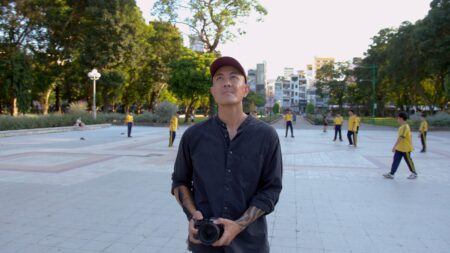Interview
Built-In Mistakes
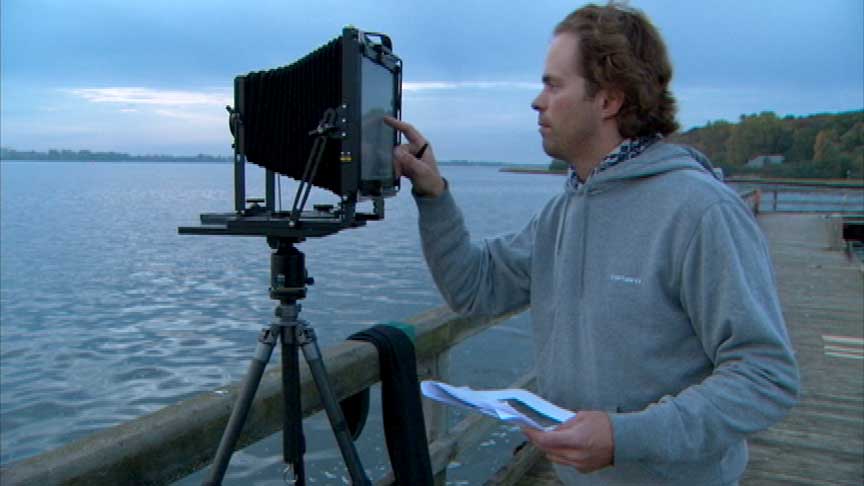
Florian Maier-Aichen takes photographs in Stralsund, Germany, 2008. Production still from the "Art in the Twenty-First Century" Season 5 episode, "Fantasy," 2009. © Art21, Inc. 2009.
In this interview from 2008, conducted at the artist’s Los Angeles studio, Florian Maier-Aichen discusses his beginnings as an artist, the evolution of his hybrid practice, and his respect for nineteenth-century landscape photographers.
Art21: When you look back at your childhood, were you always interested in art and photography? Where did it start for you?
Maier-Aichen: My dad was an artist, and I was dragged around to museums as a kid. I didn’t necessarily like it but I think it started my interest in art. And we always had cameras in the house. At some point, I started to use them. Back then I was more involved in the process, so I decided to have a small lab of my own to process my own film and print my own negatives.
Art21: What’s the earliest work you can remember that marked the point when you stopped being a student and felt like, “Okay, I really have something”? Is there a work that is the quintessential beginning for you?
Maier-Aichen: The quintessential, “real” beginning for me was when I came to UCLA or when I came to California. I didn’t come for its scenic beauty; I came for the artists who were teaching at UCLA. The art they were making was exactly the art that I liked, and it was a great bonus that they were also actually teaching. It seemed uncommon for me to see those important artists do their day jobs and teach as well. One of the reasons why I thought Los Angeles would be interesting, in terms of photography, was that while German photography was actually kind of starting to repeat itself, there were people working in Los Angeles (like James Welling or Christopher Williams) who used the medium in a more thoughtful way. They investigated more—and dug deeper down into the medium—rather than just creating pictures. The good thing about UCLA was that I usually had one-on-one discussions with my teachers. Studying with John Baldessari meant that we would hang out in my studio (by the time I was working with him, I was working on a sculpture) and discuss the work on a very non-theoretical level, in a hands-on approach—not even throwing ideas off of each other, and maybe not even talking about art, but just having everyday plain conversation. What I learned was that sometimes you can do things wrong and do things the way you’re not supposed to do them. Baldessari was breaking every rule that there was, so it was a huge encouragement for me to question things or standards a little more. A good way to sum it up would be to say that it was okay to just “go wrong.”
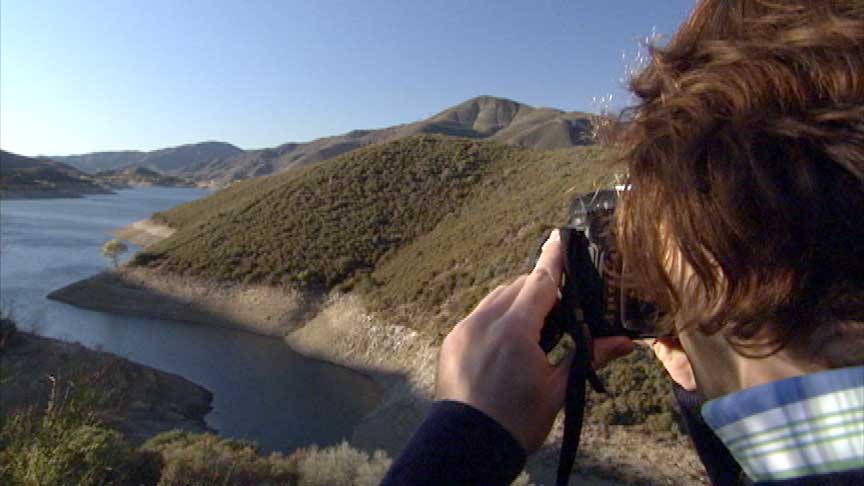
Florian Maier-Aichen takes photographs in Santa Clarita, California, 2008. Production still from the “Art in the Twenty-First Century” Season 5 episode, “Fantasy,” 2009. © Art21, Inc. 2009.
Art21: Talk to me about experimenting.
Maier-Aichen: People usually think there’s not much experimenting with a large format camera—that it’s a very static process with no possibility for fast action or accident. But sometimes things go wrong, like the camera leaks or the film is too old or the lab might make mistakes. Sometimes it’s nice to build in mistakes yourself. For example, I waited a couple of minutes for clouds to move in Untitled (2007). I don’t really like generic photography, or the idea of depicting reality exactly.

Florian Maier-Aichen. Untitled, 2007. C-print; 47 7/8 × 60 1/2 inches. © Florian Maier-Aichen. Courtesy of Blum & Poe, Los Angeles and 303 Gallery, New York.
Art21: You’re a photographer yet you do so much handwork—you’re constantly drawing.
Maier-Aichen: You probably would dismiss a term like painter-photographer or draftsman-photographer because it’s almost like a hybrid, which people never like. You want to be either in this category or that. But what I like is that I turn the finished photograph almost back into a scribble. Usually a photograph is very finished, precise, and rigorous. It’s an end product. But I like to use the end product and turn it into an unfinished state again. Most people think photography and painting should be strictly separate, even though photography has always mimicked painting because of a kind of inferiority complex (it wasn’t considered artistic enough). The first photographers tried to use painterly devices until straight photography came into fashion and all the modern photographers got rid of the painterly baggage. But I think, today, that photography has become so technical that people have tried to investigate the medium again by researching process or photography’s historical importance. I don’t want to be a dogmatist, so I think that it’s fine to combine photography and drawing, or alter photographs and bring in fictional elements, or just not be satisfied with photography as a super-realistic medium.
Art21: How did come to the idea of drawing, scribbling on photographs?
Maier-Aichen: It just happened over the years. At first I was using the computer in the traditional way. I thought, “Okay, this photograph is not polished enough; I need to get rid of some clouds, make it more perfect, touch it up.” Then I started to investigate the computer even more and realized that you can use it to add elements. The computer has made everything much simpler but it has also opened up many more possibilities. One of the big dangers with a computer is that images become too clean, for example, like fashion shots or commercial work. But I think of the computer not so much as a tool for cleaning up and polishing photographs as a tool that gives me possibilities to draw on photos or even enhance them. It has helped me to loosen up with my camera work since I can always go back later and even try to incorporate whatever accidents might have happened. So I’m not a perfectionist. The actual image that I get tomorrow or the next day doesn’t have to be that good because that’s only half of the process. And I construct to a degree that’s not necessarily linked to actuality anymore. It’s more like an idealized image—maybe like the way postcards used to work, almost as fantasies. Sometimes I work on images for a week, or sometimes it takes months. I like to work on a lot of photographs simultaneously so that I don’t just get lost in one. I let it sit and then I just start again a couple of days later with a fresh view.
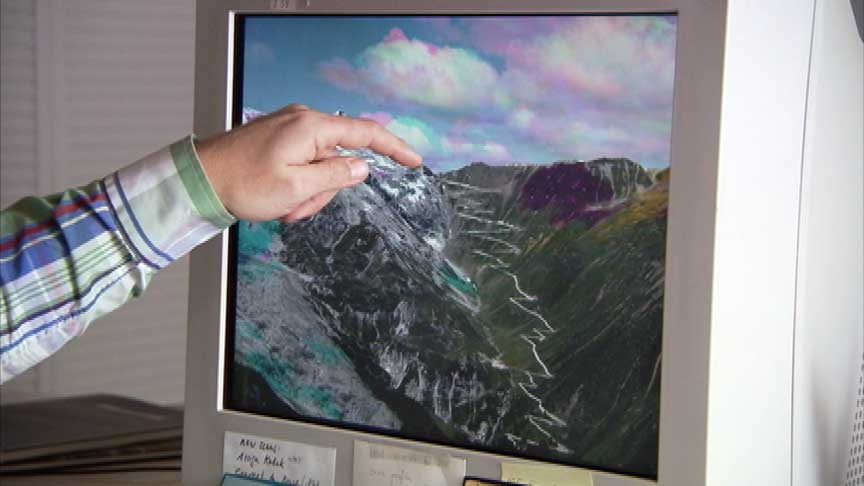
Florian Maier-Aichen in his studio, Los Angeles, California, 2008. Production still from the “Art in the Twenty-First Century” Season 5 episode, “Fantasy,” 2009. © Art21, Inc. 2009.
Art21: Would you say that your initial photograph is like a canvas or a base?
Maier-Aichen: It’s a base, yes. It’s a starting point for me. A lot of painters use photographs as their base because the camera records everything you need or want to copy. It’s a technical tool. Sometimes I see an interesting image and I think it makes sense to go there and re-photograph the site. For example, I was reading about [the architect] William Mulholland and saw the St. Francis dam and thought, “Okay, this could be an interesting site.” So I took a photograph of the remains of the dam and based my standpoint on one of the first photographs of the dam in the 1930s. I didn’t have to worry much about composition and that makes it easier for me to focus on the picture itself.
Art21: So what are you looking for when you go to a site?
Maier-Aichen: My goal is to get close to the reference image, not create another composition. And usually there is no better composition. For example, the 1930s image of the dam is still the best spot to take a photograph. At this one curve of the road is where you have the best vista. I like that I’ve already been given a standpoint. And working this way fits well with my wanting to pay homage to pioneer photographers.
Art21: Which artists have influenced you most?
Maier-Aichen: I like to look backwards for my influences. The Bisson brothers, who were French photo pioneers, were the first to photograph the Alps. It was a huge process back then because you had to bring all the chemistry and all the ingredients to the mountains. I also saw a show of Carleton Watkins once and it was the same thing, but it was just about California. The seascapes of Gustave Le Gray, another French photographer, also made a huge impression on me. These are the historical references that I like to look back to—all early nineteenth-century photographers—and I can still work off of just these three names and use them in my everyday work.
When I look at American landscape painting from the nineteenth-century I always have in mind one painting of Yosemite by Albert Bierstadt. Yosemite is already such a theatrical place—almost like a too-drastic landscape—and Bierstadt just added more to it. He turned it into a complete fantasy by getting rid of the facts and enhancing every other aspect of Yosemite. Half Dome is an iconic image, but when I saw that Carleton Watkins had used it in one of his photographs back in the nineteenth-century, it became more significant for me. Suddenly I wanted not to remake the same image but to go there and work with the subject.
I couldn’t access Watkins’s standpoint anymore because it was overgrown, so I used Glacier Point, which is next door. It’s the most generic vista or viewpoint that you can get in Yosemite. It wasn’t a perfect day when I took the photograph, and I didn’t mind because it was just a starting point. I drew in the entire background with the blue sky and the clouds, and I brought in the bushes to make some foreground space. So in the end the image, except for Half Dome, is not really the way it looked when I took the picture.
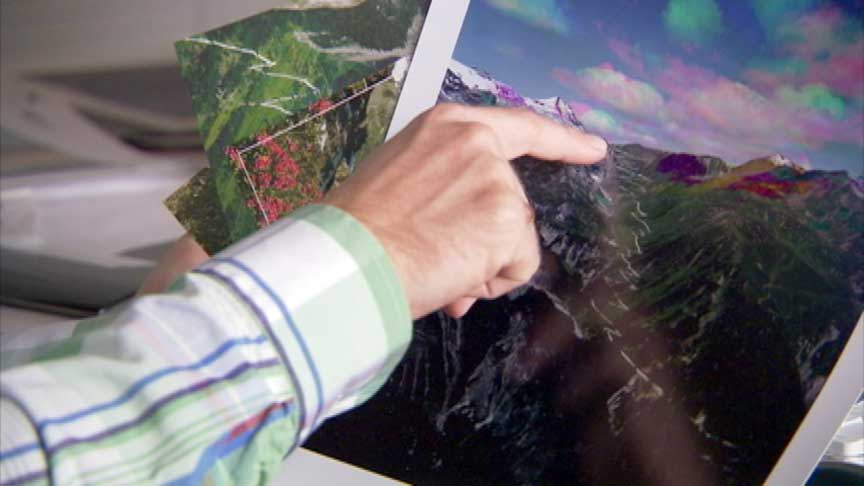
Florian Maier-Aichen in his studio, Los Angeles, California, 2008. Production still from the “Art in the Twenty-First Century” Season 5 episode, “Fantasy,” 2009. © Art21, Inc. 2009.
Art21: In many cases your work is quite large. Tell me how you think about scale?
Maier-Aichen: When you turn photos into objects you have to treat each one individually and determine the right size or scale for it. Some of the works might be huge vistas, and you hang them low so that you can actually look downwards on them. A huge vista might work as a map, and since you need to be able to inspect every detail it needs to be big enough that you can actually get lost in one corner without getting distracted by the other corner. But if I need to create a photo context I would print it really small and matte it so that it just plays by those conventions. Because I don’t do serial work, every piece needs its own size, presentation, and scale. I like to turn a photograph into an unfinished product because I think it has lost a lot of its status and has become very technical. So it’s interesting to deconstruct a photograph and make it more open-ended—like a map, as I said, or like the way I use the city as a sort of generic place on which you project whatever you wish. That way it doesn’t become too closed in terms of meaning.
Interviewer: Susan Sollins. Content Editors: Marybeth Sollins and Nicole J. Caruth. Published: February 2014. © Art21, Inc. Artwork: Courtesy Blum & Poe, Los Angeles and 303 Gallery, New York.
